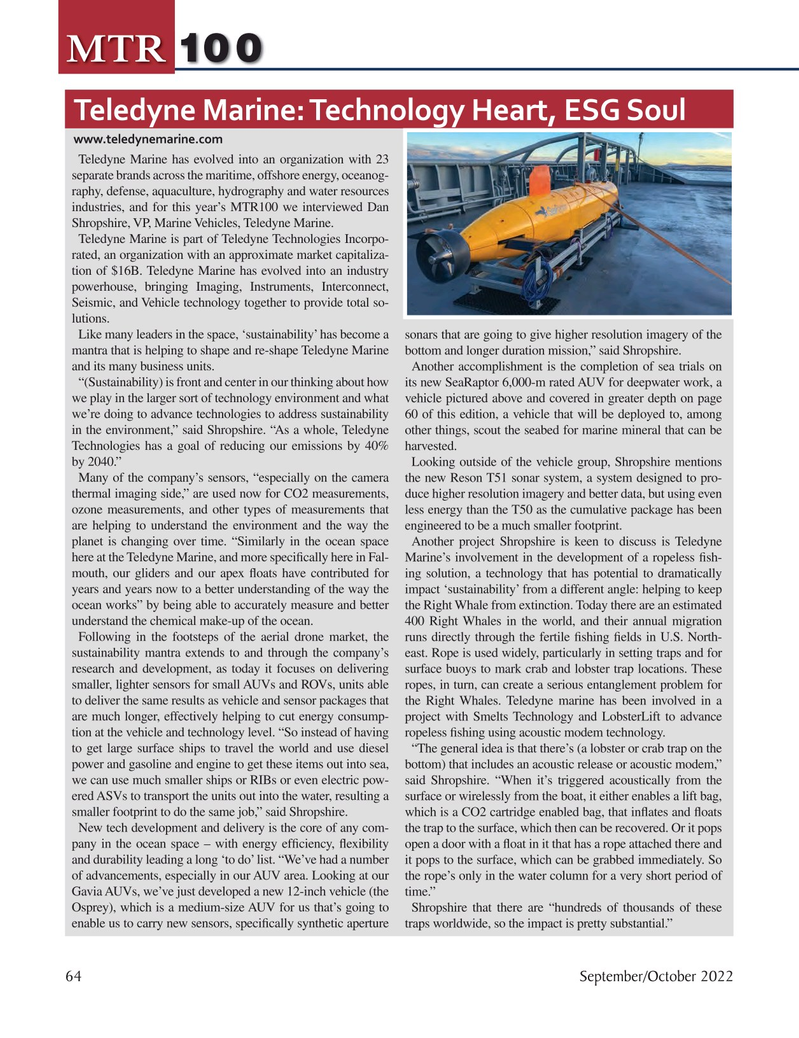
Page 64: of Marine Technology Magazine (September 2022)
Read this page in Pdf, Flash or Html5 edition of September 2022 Marine Technology Magazine
MTR 100
Teledyne Marine: Technology Heart, ESG Soul www.teledynemarine.com
Teledyne Marine has evolved into an organization with 23 separate brands across the maritime, offshore energy, oceanog- raphy, defense, aquaculture, hydrography and water resources industries, and for this year’s MTR100 we interviewed Dan
Shropshire, VP, Marine Vehicles, Teledyne Marine.
Teledyne Marine is part of Teledyne Technologies Incorpo- rated, an organization with an approximate market capitaliza- tion of $16B. Teledyne Marine has evolved into an industry powerhouse, bringing Imaging, Instruments, Interconnect,
Seismic, and Vehicle technology together to provide total so- lutions.
Like many leaders in the space, ‘sustainability’ has become a sonars that are going to give higher resolution imagery of the mantra that is helping to shape and re-shape Teledyne Marine bottom and longer duration mission,” said Shropshire.
and its many business units. Another accomplishment is the completion of sea trials on “(Sustainability) is front and center in our thinking about how its new SeaRaptor 6,000-m rated AUV for deepwater work, a we play in the larger sort of technology environment and what vehicle pictured above and covered in greater depth on page we’re doing to advance technologies to address sustainability 60 of this edition, a vehicle that will be deployed to, among in the environment,” said Shropshire. “As a whole, Teledyne other things, scout the seabed for marine mineral that can be
Technologies has a goal of reducing our emissions by 40% harvested.
by 2040.” Looking outside of the vehicle group, Shropshire mentions
Many of the company’s sensors, “especially on the camera the new Reson T51 sonar system, a system designed to pro- thermal imaging side,” are used now for CO2 measurements, duce higher resolution imagery and better data, but using even ozone measurements, and other types of measurements that less energy than the T50 as the cumulative package has been are helping to understand the environment and the way the engineered to be a much smaller footprint. planet is changing over time. “Similarly in the ocean space Another project Shropshire is keen to discuss is Teledyne here at the Teledyne Marine, and more speci? cally here in Fal- Marine’s involvement in the development of a ropeless ? sh- mouth, our gliders and our apex ? oats have contributed for ing solution, a technology that has potential to dramatically years and years now to a better understanding of the way the impact ‘sustainability’ from a different angle: helping to keep ocean works” by being able to accurately measure and better the Right Whale from extinction. Today there are an estimated understand the chemical make-up of the ocean. 400 Right Whales in the world, and their annual migration
Following in the footsteps of the aerial drone market, the runs directly through the fertile ? shing ? elds in U.S. North- sustainability mantra extends to and through the company’s east. Rope is used widely, particularly in setting traps and for research and development, as today it focuses on delivering surface buoys to mark crab and lobster trap locations. These smaller, lighter sensors for small AUVs and ROVs, units able ropes, in turn, can create a serious entanglement problem for to deliver the same results as vehicle and sensor packages that the Right Whales. Teledyne marine has been involved in a are much longer, effectively helping to cut energy consump- project with Smelts Technology and LobsterLift to advance tion at the vehicle and technology level. “So instead of having ropeless ? shing using acoustic modem technology.
to get large surface ships to travel the world and use diesel “The general idea is that there’s (a lobster or crab trap on the power and gasoline and engine to get these items out into sea, bottom) that includes an acoustic release or acoustic modem,” we can use much smaller ships or RIBs or even electric pow- said Shropshire. “When it’s triggered acoustically from the ered ASVs to transport the units out into the water, resulting a surface or wirelessly from the boat, it either enables a lift bag, smaller footprint to do the same job,” said Shropshire. which is a CO2 cartridge enabled bag, that in? ates and ? oats
New tech development and delivery is the core of any com- the trap to the surface, which then can be recovered. Or it pops pany in the ocean space – with energy ef? ciency, ? exibility open a door with a ? oat in it that has a rope attached there and and durability leading a long ‘to do’ list. “We’ve had a number it pops to the surface, which can be grabbed immediately. So of advancements, especially in our AUV area. Looking at our the rope’s only in the water column for a very short period of
Gavia AUVs, we’ve just developed a new 12-inch vehicle (the time.”
Osprey), which is a medium-size AUV for us that’s going to Shropshire that there are “hundreds of thousands of these enable us to carry new sensors, speci? cally synthetic aperture traps worldwide, so the impact is pretty substantial.” 64 September/October 2022
MTR #7 (50-65).indd 64 10/3/2022 12:13:41 PM

 63
63

 65
65
